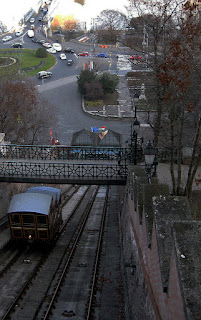Breakfast yesterday was a feast, so I started the day well, and when I plunged out into the freezing weather I made for what is said to be the most exciting part of the city to explore, the area around the castle. They did not lie! I walked to the Szechenyi Chain Bridge and crossed over the Danube.
 |
| Szechenyi Chain Bridge with part of castle complex in the background |
At the end of that bridge the walker is faced with a steep climb, but there is also a funicular at the bottom.
 |
| The funicular |
But Dottore Gianni was drawn to look the other way, back at the Pest side of the city and the brilliant views of that part of town as well as of up and down the Danube. As good as the tour books claim! Once sated, I turned round and tried to decide which way to proceed. To the left are the museums, free with my Budapest Card, which I purchased yesterday morning. I opted to head right, the tower of Mathias Church drawing me in that direction.
But before I proceed, a brief history may be in order, a tale of various conquests and occupations. The castle district was first occupied in the 13th century, after the Mongol attacks on the area. Then the royal court moved in and by the 15th century, under the leadership of King Mathias, Buda's importance grew mightily.The next invaders were the Ottoman Turks, who invaded in 1541 and ruled Buda as well as much of the rest of Eastern Europe for more than a century, when another set of invaders, the Hapsburg Empire, centered in Austria, invaded in 1686. During the siege that it took to win Buda, the Hapsburgs left the castle district in ruins. But they quickly rebuilt it in the baroque style popular in the era, it became the center of the government in Buda, and remained much as it looks today until the end of World War II, when it was once more destroyed, this time by the Allied armies, specifically the Russians. The ruins were once more reconstructed , so that they looked as they had before that war, and thus it remains today, an elegant replica of an eighteenth century city.
The castle hill looks down not only on Pest and the Danube, but if you walk a few hundred meters in the opposite direction you''ll see that it overlooks the rest of Buda as well. I did not venture down into that part of the city, as the castle area itself occupied my time for more than three hours.
If all the imposing and impressive buildings in this area, the one I really took to was Mathias Church, as I noted above.
 |
| Mathias Church |
 |
| Mathias Church |
 |
| Fishermen's Bastion |
 |
| Colorful houses in castle area Ar the rear right the National Archives |
The road divides into two for a bit so I walked towards the archives building, then turned back up the other fork in the road and happened onto the Museum of Music History, which just happened to be displaying an exhibition on Franz Liszt and the Arts. I walked in, the admission was covered by my Budapest Card, and I was ushered into a really delightful three or four rooms on Liszt, the great Hungarian Romantic composer/performer, his music, and the many other artists he worked with. A delightful surprise, well worth my time, and a much needed chance to warm up!
I next decided to head back in the direction I'd come from and see about the rest of this vast complex.
 |
| Part of the museum complex, from the door of the History Museum |
I was running out of time and steam and had time only for one. I chose the history museum and was rewarded with a very smart exhibit on 1,000 years of Hungary. I should mention that there are English language translations of the Hungarian throughout, and when I left I felt I had a pretty good sense of the history of this fascinating place. By the time I was ready to descend back into Pest it was about 1:30 pm. When I re-crossed the river I was faced with two pooibilities: heading back to the hotel for a nap or trying to see a few more sights.
I opted for the latter and was glad I did. I walked along Andrassy Avenue, filled with posh shops and eateries, until I came upon a real architectural gem. the opera house.
 |
| The Opera House |
 |
| St Stephen's Basilica |
 |
| Entrance to the Christmas Fair Vorosmarty Square |



No comments:
Post a Comment